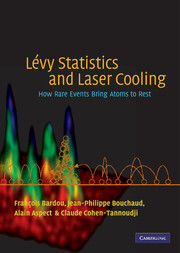Book contents
- Frontmatter
- Contents
- Foreword
- Acknowledgements
- 1 Introduction
- 2 Subrecoil laser cooling and anomalous random walks
- 3 Trapping and recycling. Statistical properties
- 4 Broad distributions and Lévy statistics: a brief overview
- 5 The proportion of atoms trapped in quasi-dark states
- 6 The momentum distribution
- 7 Physical discussion
- 8 Tests of the statistical approach
- 9 Example of application: optimization of the peak of cooled atoms
- 10 Conclusion
- Appendix A Correspondence between parameters of the statistical models and atomic and laser parameters
- Appendix B The Doppler case
- Appendix C The special case µ = 1
- References
- Index of main notation
- Index
5 - The proportion of atoms trapped in quasi-dark states
Published online by Cambridge University Press: 06 July 2010
- Frontmatter
- Contents
- Foreword
- Acknowledgements
- 1 Introduction
- 2 Subrecoil laser cooling and anomalous random walks
- 3 Trapping and recycling. Statistical properties
- 4 Broad distributions and Lévy statistics: a brief overview
- 5 The proportion of atoms trapped in quasi-dark states
- 6 The momentum distribution
- 7 Physical discussion
- 8 Tests of the statistical approach
- 9 Example of application: optimization of the peak of cooled atoms
- 10 Conclusion
- Appendix A Correspondence between parameters of the statistical models and atomic and laser parameters
- Appendix B The Doppler case
- Appendix C The special case µ = 1
- References
- Index of main notation
- Index
Summary
We now have all the mathematical tools in hand to address the important questions for the cooling process, namely: what is the proportion ftrap(θ) of ‘trapped’ atoms (i.e. those which have a very small momentum p < ptrap); what is the ‘line shape’, i.e. the momentum distribution, after an interaction time θ?
In Section 5.1, we define precisely the trapped proportion ftrap(θ) in terms of an ensemble average and compare it to a time average defined as the mean fraction of the time spent in the trap. The two averages do not always coincide, as shown by the explicit computation of Section 5.2. This reveals the non-ergodic character of the cooling process, as discussed in Section 5.3.
Ensemble averages versus time averages
We define the trapped proportion ftrap(θ) as the probability of finding the atom in the trap at time t = θ. Therefore, ftrap(θ) corresponds to an ensemble average, over many independent realizations of the stochastic process of Fig. 3.1. It is instructive to consider also a time average, by examining how a given atom shares its time between the ‘inside’ and the ‘outside’ of the trap. Because of the non-ergodic character of subrecoil laser cooling, ensemble averages and time averages do not in general coincide. In fact, we will see later on that the ensemble average ftrap(θ) and the time average only coincide when 〈τ〉 and are finite, whereas they differ when either µ or is smaller than one.
- Type
- Chapter
- Information
- Lévy Statistics and Laser CoolingHow Rare Events Bring Atoms to Rest, pp. 60 - 68Publisher: Cambridge University PressPrint publication year: 2001



